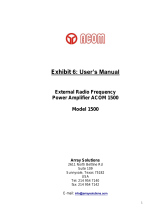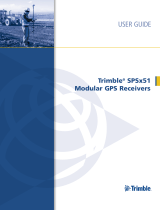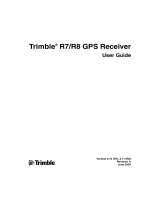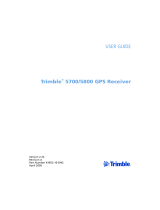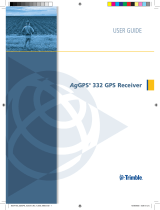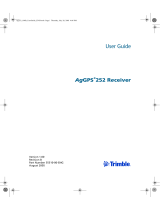Page is loading ...

John Deere RTK Radio 450
OPERATOR'S MANUAL
John Deere RTK Radio 450
OMPFP10922 ISSUE J1 (ENGLISH)
CALIFORNIA
Proposition 65 Warning
Diesel engine exhaust and some of its constituents
are known to the State of California to cause cancer,
birth defects, and other reproductive harm.
If this product contains a gasoline engine:
WARNING
The engine exhaust from this product contains
chemicals known to the State of California to cause
cancer, birth defects or other reproductive harm.
The State of California requires the above two warnings.
Additional Proposition 65 Warnings can be found in this manual.
John Deere Werke Zweibrücken
Worldwide Version
PRINTED IN U.S.A.
DCYOMPFP10922

Introduction
OUO6050,0000FB1 -19-10AUG10-1/1
www.StellarSupport.com
NOTE: Product functionality may not be fully represented in this document due to product changes occurring after the time of printing. Read the
latest Operator's Manual and Quick Reference Guide prior to operation. To obtain a copy, see your dealer or visit www.StellarSupport.com
092711
PN=2

Contents
Page
Safety
Recognize Safety Information ............................05-1
Understand Signal Words...................................05-1
Follow Safety Instructions...................................05-1
Practice Safe Maintenance.................................05-2
Handle Electronic Components and
Brackets Safely ..............................................05-2
Prevent Electrical Shock and Fires.....................05-3
Avoid Exposure to High Radio
Frequency Fields............................................05-3
Avoid Electrical Power Lines ..............................05-4
Safety Sign
Antenna Front View Decal..................................10-1
FCC NOTIFICATIONS TO USER
FCC NOTIFICATION ..........................................15-1
450 MHz RTK .....................................................15-1
COUNTRY USE RESTRICTIONS......................15-1
Licensing of John Deere RTK Radio 450
Licensing of John Deere RTK Radio 450 ...........20-1
John Deere RTK Radio 450 Compatability.........20-1
RTK Base Station Setup
System Overview................................................25-1
Vehicle Receiver.................................................25-2
Base Station Setup.............................................25-3
Base Station Setup—Amplier Option
(USA and Canada only) .................................25-4
Base Station Setup—Dual Radio (USA
and Canada only)...........................................25-6
Radio Power Setting to Meet Licensed ERP ......25-9
GS3 Display SF3000—John Deere RTK Radio 450
RTK SoftKey.......................................................30-1
Screens Common to Standard
(869MHz, 900MHz) and RTK Radio 450 .......30-2
RTK Main Page ..................................................30-2
RTK Congure Page ..........................................30-4
Diagnostic LEDs
Diagnostic LEDs.................................................35-1
RTK Radio 450 LEDs .........................................35-1
Amplier LEDs (USA and Canada only).............35-2
Page
RTK Radio 450 Performance
RTK Radio 450 Accuracy ...................................40-1
Radio Self Test ...................................................40-1
Line of Sight........................................................40-3
Operation of Vehicle Next to Base......................40-4
EC Declaration of Conformity .............................40-4
Original Instructions. All information, illustrations and specications in this
manual are based on the latest information available at the time of publication.
The right is reserved to make changes at any time without notice.
COPYRIGHT © 2011
DEERE & COMPANY
Moline, Illinois
All rights reserved.
A John Deere ILLUSTRUCTION ® Manual
i
092711
PN=1

Contents
ii
092711
PN=2

Safety
DX,ALERT -19-29SEP98-1/1
DX,SIGNAL -19-03MAR93-1/1
DX,READ -19-16JUN09-1/1
Recognize Safety Information
This is a safety-alert symbol. When you see this symbol
on your machine or in this manual, be alert to the potential
for personal injury.
Follow recommended precautions and safe operating
practices.
T81389 —UN—07DEC88
Understand Signal Words
A signal word—DANGER, WARNING, or CAUTION—is
used with the safety-alert symbol. DANGER identies the
most serious hazards.
DANGER or WARNING safety signs are located near
specic hazards. General precautions are listed on
CAUTION safety signs. CAUTION also calls attention to
safety messages in this manual.
TS187 —19—30SEP88
Follow Safety Instructions
Carefully read all safety messages in this manual and on
your machine safety signs. Keep safety signs in good
condition. Replace missing or damaged safety signs. Be
sure new equipment components and repair parts include
the current safety signs. Replacement safety signs are
available from your John Deere dealer.
There can be additional safety information contained on
parts and components sourced from suppliers that is not
reproduced in this operator's manual.
Learn how to operate the machine and how to use controls
properly. Do not let anyone operate without instruction.
Keep your machine in proper working condition.
Unauthorized modications to the machine may impair the
function and/or safety and affect machine life.
TS201 —UN—23AUG88
If you do not understand any part of this manual and need
assistance, contact your John Deere dealer.
05-1
092711
PN=5

Safety
DX,SERV -19-17FEB99-1/1
DX,WW,RECEIVER -19-24AUG10-1/1
Practice Safe Maintenance
Understand service procedure before doing work. Keep
area clean and dry.
Never lubricate, service, or adjust machine while it is
moving. Keep hands, feet , and clothing from power-driven
parts. Disengage all power and operate controls to relieve
pressure. Lower equipment to the ground. Stop the
engine. Remove the key. Allow machine to cool.
Securely support any machine elements that must be
raised for service work.
Keep all parts in good condition and properly installed.
Fix damage immediately. Replace worn or broken parts.
Remove any buildup of grease, oil, or debris.
On self-propelled equipment, disconnect battery ground
cable (-) before making adjustments on electrical systems
or welding on machine.
On towed implements, disconnect wiring harnesses from
tractor before servicing electrical system components or
welding on machine.
TS218 —UN—23AUG88
Handle Electronic Components and Brackets
Safely
Falling while installing or removing electronic components
mounted on equipment can cause serious injury. Use a
ladder or platform to easily reach each mounting location.
Use sturdy and secure footholds and handholds. Do not
install or remove components in wet or icy conditions.
If installing or servicing a RTK base station on a tower or
other tall structure, use a certied climber.
If installing or servicing a global positioning receiver mast
used on an implement, use proper lifting techniques and
wear proper protective equipment. The mast is heavy and
can be awkward to handle. Two people are required when
mounting locations are not accessible from the ground
or from a service platform.
TS249 —UN—23AUG88
05-2
092711
PN=6

Safety
JS56696,0000A47 -19-27JUL11-1/1
JS56696,0000A46 -19-27JUL11-1/1
Prevent Electrical Shock and Fires
To prevent injury from electrical shock, always disconnect
power to the receiver, antenna, and amplier before
installing or servicing.
If installing with the power amplier option, prevent
electrical shock or re by using a 14 AWG heavy-duty
electrical cord with 15 amp rating suitable for outdoor use.
Understand and follow all local codes and regulations
when installing electrical equipment.
PC12631 —UN—04JUN10
Avoid Exposure to High Radio Frequency
Fields
Prevent injury from exposure to high radio frequency elds
at an RTK base station. Do not touch the antenna while
the system is transmitting. Always disconnect power to the
receiver, radio, and amplier before installing or servicing.
While the RTK base station amplier and radio are
operating together, stay at least 3.6 m (12 ft.) away from
the base antenna.
While using the base station radio without the amplier
option, stay at least 40 cm (16 in.) away from the radio
antenna.
PC12632 —UN—04JUN10
05-3
092711
PN=7

Safety
JS56696,00008AC -19-03JUN10-1/1
Avoid Electrical Power Lines
Watch for wires. Do not install the base antenna near
power lines. It may come into contact with low-hanging
electrical cables. This would result in the installer suffering
serious injury or death from electrocution.
PUPC000036 —UN—09DEC09
05-4
092711
PN=8

Safety Sign
DK01672,000014B -19-26JUL11-1/1
Antenna Front View Decal
CAUTION: To avoid serious injury or death
from electrocution. Do not come into contact
with electrical lines.
PUPC000037 —UN—10DEC09
Antenna Front View Decal Location
PC13795 —UN—25MAY11
USA, Canada, Australia and New
Zealand Antenna Decal
PC13794 —UN—25MAY11
General Antenna Decal (except
for US, CA, NZ and AU)
10-1
092711
PN=9

FCC NOTIFICATIONS TO USER
DK01672,0000136 -19-22JUL11-1/1
DK01672,0000137 -19-22JUL11-1/1
DK01672,0000108 -19-15JUL11-1/1
FCC NOTIFICATION
These devices comply with Part 15 of the FCC Rules
Operation subject to the following two conditions.
1. These devices may not cause harmful interference.
2. These devices must accept any interference received,
including interference that may cause undesired
operation.
These devices must be operated as supplied by John
Deere Ag Management Solutions. Any changes or
modications made to these devices without the express
written approval of John Deere Ag Management Solutions
may void the user’s authority to operate these devices.
450 MHz RTK
This equipment has been tested and found to comply with
the limits for a Class A digital device, pursuant to Part 15
of the FCC Rules. These limits are designed to provide
reasonable protection against harmful interference when
the equipment is operated in a commercial environment.
This equipment generates, uses, and can radiate radio
frequency energy and, if not installed and used in
accordance with the instruction manual, may cause
harmful interference to radio communications. Operation
of this equipment in a residential area is likely to cause
harmful interference in which case the user will be
required to correct the interference at the user’s expense.
COUNTRY USE RESTRICTIONS
The John Deere RTK Radio 450 is designed to operate
on frequency ranges, the exact use of which differs from
one region and/or country to another. The user of the
radio modem must take care that the said device is not
operated without permission of the local authorities on
frequencies other than those specically reserved and
intended for use without a specic permit. Refer to table
Radio Power Setting to Meet Licensed ERP in this OM.
IMPORTANT: Please contact your local radio
authorities for country specic regulations
and licensing
15-1
092711
PN=10

Licensing of John Deere RTK Radio 450
DK01672,0000140 -19-25JUL11-1/1
DK01672,0000141 -19-25JUL11-1/1
Licensing of John Deere RTK Radio 450
The standard (869MHz, 900MHz) RTK product sold by
John Deere uses ISM band radios. These radios do not
require licensing by the end user. The radios are limited
to a specic frequency range and 1W/ 0.5W maximum
output power. While this system works for the majority of
applications, the reliability of the RTK link may become
limited when passing through trees and dense foliage.
The intent of RTK Radio 450 is to increase the range and
reliability of the RTK link. To overcome the attenuation
of adverse eld conditions, transmission power greater
than standard (869MHz, 900MHz) RTK is needed. While
there is some added benet from using a radio with lower
frequency and longer wavelength, the signal strength
is the dominant factor in the radio link reliability. To
legally transmit at a higher power, RTK Radio 450 uses
a licensed band radio. The end user of the licensed
band transmitting radio is responsible for obtaining and
maintaining a valid site license from the local spectrum
authorities. In RTK Radio 450 system, this requires a
license for each base station and repeater.
Vehicle radios in RTK Radio 450 system are not
transmitters. Since they only receive corrections from the
base or repeater, RTK Radio 450 vehicle radios do not
require a site license.
An end user can apply for the license by applying directly
to the local spectrum authority:
NOTE: Visit www.StellarSupport.com for license
request examples and links to Authority for
different countries.
An end user can also apply with the aid of a frequency
coordinator. A frequency coordinator is a private company
that has been certied by the local frequency spectrum
authority to recommend and aid in the application for a
licenses. For a fee, these third party coordinators will
reduce the complexity and confusion of the application
process. However, the nal responsibility of the license
still resides with the end user.
Check www.StellarSupport.com for country specic
instructions on how to obtain a site license.
IMPORTANT: Please contact your local radio
authorities or partnering frequency coordinator
for region specic regulations and licensing.
License Renewal Scams
After being granted a license for RTK Radio 450 radio,
base station operators should be aware of license
renewal scams. Spectrum licenses are public record.
Other companies could retrieve licensee information
and then mail current license holders offers to prepare
applications for license renewal. The letters contain
warnings that there will be monetary penalties if the
licensee does not comply. These companies are not
afliated with government spectrum authorities. They are
taking advantage of the public record and the licensee’s
desire to comply with the law. Their intention is to charge
a “processing” fee on top of the actual amount that a
licensee would pay for renewal. While it is important to
not let your license expire, licensees should work directly
with their local spectrum authority or a certied frequency
coordinator. Internet searches of the companies involved
usually identify if the company is relevant.
John Deere RTK Radio 450 Compatability
Base Station
Vehicle
StarFire
iTC
Vehicle
StarFire
3000
StarFire iTC YES YES
StarFire 3000 + Glonass YES YES
StarFire 3000 + Glonass + Repeaters NO YES
IMPORTANT: If a Repeater is used in the John Deere
RTK Radio 450 network it’s recommended
to use StarFire 3000 receivers only for Base
Station and Vehicles. Also uncheck the
“Repeater in Network” function in the StarFire
setup - Congure RTK Network menu if a
StarFire iTC is in the network.
20-1
092711
PN=11

RTK Base Station Setup
BA31779,00001CE -19-23MAY11-1/1
System Overview
The John Deere RTK Radio 450 system consists of a
local base station permanently mounted on a structure
that transmits high accuracy corrections to the vehicle’s
StarFire™ receiver using RTK Radio 450 and an optional
amplier (only available in USA and Canada). The
StarFire™ receiver on the RTK equipped vehicle must
have a direct line of sight with the base station in order to
receive the RTK signal. While the higher transmission
power and longer wavelength of RTK Radio 450 aids
in the transmission through trees and foliage, it will not
penetrate through earth in hilly terrains.
Performance of the RTK correction is related to the
operating distance from the base station. When operating
beyond 20 km (12 mi.), degraded accuracy will occur and
it may take longer to initially acquire the RTK signal.
IMPORTANT: The standard (869MHz, 900MHz) RTK
system and RTK Radio 450 systems are not
compatible. Vehicles with RTK Radio 450
must receive corrections from a RTK Radio
450 attached to the base. Likewise, vehicles
with standard (869MHz, 900MHz) radios
installed must receive there corrections from
a base with a standard (869MHz, 900MHz)
radio installed. Different radio models can
not communicate with each other since they
transmit on different frequencies.
25-1
092711
PN=12

RTK Base Station Setup
DK01672,000012E -19-21JUL11-1/1
Vehicle Receiver
PC13760 —UN—17MAY11
RTK Receiver on Top of Cab
PUPC000003 —UN—03DEC09
Wire Bracket on Top of Cab
Position receiver with integrated RTK radio module is
located on top of machine.
Position receiver combines the global positioning signals
it receives with the RTK differential correction via the
radio link to provide accurate position information to the
GreenStar™ system.
The receiver has a dedicated operating mode (Vehicle
Mode). Refer to Operating Mode—RTK in Section
StarFire 3000 for setup of the receiver on vehicle.
IMPORTANT: The antenna must be installed before
the radio module is powered ON.
Avoid water intrusion by keeping the antenna
attached whenever possible.
Removing the antenna while powered may
damage the radio module.
The RTK Radio 450 system is only compatible with the
deluxe shroud. This may require a conversion bracket
for installation.
PC13782 —UN—19MAY11
Mannheim Tractor Conversion Bracket
GreenStar is a trademark of Deere & Company
25-2
092711
PN=13

RTK Base Station Setup
Continued on next page DK01672,0000145 -19-25JUL11-1/2
Base Station Setup
The base station is the most critical part of RTK system.
During installation, care must be taken to ensure the base
has problem-free operation. There are two issues that
are responsible for most problems with a base station:
Shading and Multipathing. If a base station experiences
one of these problems, it could be detrimental to your RTK
operation. These issues are shared with the standard
(869MHz, 900MHz) RTK system. Mitigation techniques
have already been documented in the standard StarFire
3000 – RTK manual that came with the StarFire receiver.
This manual provides detailed recommendations to
minimizing these errors.
Base station operating mode can be either Absolute
Survey Base Mode or Quick Survey Base Mode.
NOTE: Quick Survey Base Mode is for testing
purposes only. this mode can be used to test the
functionality without doing the 24h measurement
with Absolute Survey Base Mode.
Once you have installed the base station receiver,
installing the radio in a location to best maximize the
output, can be a challenge. Below are several options
currently available through John Deere.
•
Leave the RTK radio in its original conguration
attached directly behind the base station receiver.
•
Use PF80821 extension harness [92 m (300 ft.) in
length], or PFP10549 MRTK and iGuide harness (5 m),
or PFP10540 MRTK and iGuide harness (10 m), or
PFP10541 MRTK and iGuide harness (20 m), moving
the radio from the back of the base station receiver to an
elevated position, and running the harness in between.
NOTE: It is important to use the PF80821 harness
and grounding wire properly according to the
installation instructions. This harness has built
in protection for both your radio and receiver
for unwanted electrical transients developed
on the harness.The Maximum recommended
harness length is 92m (300ft).
IMPORTANT: The antenna must be installed before
the radio module is powered ON.
Avoid water intrusion by keeping the
antenna attached whenever possible.
Removing the antenna while transmitting
may damage the radio module.
IMPORTANT: If using coaxial cable between the
radio and the antenna, you need to use
the lowest-loss cable available or you may
suffer RTK radio link range issues.
•
Attach the RTK radio in a secured location and run
low-loss coaxial cable between the radio and the
antenna.
NOTE: When using this option, it may be necessary
to install a higher-gain antenna and/or the
optional amplier (USA and Canada only)
to compensate for loss.
John Deere RTK Radio 450 Specications
Model
Number
PFA10094 PFA10095 PFA10096 PFA10097
Country
Russia Ukraine EU, BY, KZ,
NZ
USA, AU,
Canada
Frequency
Range
435-447
MHz
440-450
MHz
435-470
MHz
435-470
MHz
Bandwidth
Options
12.5 kHz
Modulation
level 2 GFSK
RF Baud,
12.5 kHz BW
9.6 kbps at L2
Frequency
Channels
2800 at 12.5 kHz
Output
Power
0.2-2 W
Sensitivity -108 dBm at BER 10^-3; -106 dBm at BER 10^-6
In/Out
Impedance
50 ohm
Operating
Voltage
9-15 V DC
Operating
Temperature
-30 to 60° C
Out RF
Connectors
Female TNC
Control
Connector
4-pin Deutsch
Every RTK Radio 450 radio comes standard with whip
antenna that has a TNC connection.
John Deere RTK Radio 450 Whip Antenna
Specications
Model Number PF81464
Gain
2 dBi
Frequency Range 450-470 MHz
Impedance 50 ohm
VSWR
< 2:1
RF Connector
Female N-Type
Length
13.2 in. (33.5 cm)
Model Number PFP10612
Gain
1 dBi
Frequency Range 435-450 MHz
Impedance 50 ohm
VSWR
< 2:1
RF Connector
Female N-Type
Length
13.2 in. (33.5 cm)
25-3
092711
PN=14

RTK Base Station Setup
DK01672,0000145 -19-25JUL11-2/2
Continued on next page DK01672,0000139 -19-22JUL11-1/2
John Deere RTK Radio 450 High Gain Antenna
Model Number PF81452
Gain
7 dBi
Frequency Range 435-470 MHz
Max Power
200 W (UHF)
Impedance
50 OHMS
VSWR
< 1.7:1
RF Connector
N-FEMALE
Length
81 in (2 m).
Fiberglass Tube dia
2 in (5 cm)
Base Pipe
11 in (28 cm) long, 2 3/8 in (6 cm)
dia
Wind Survival 100 MPH (161 km/h)
Always mount the radio antenna vertically to make sure
that the RTK signal is radiating outwards. If the antenna is
at an angle, it may cause the data received at the vehicle
to be lower than expected.
NOTE: The RTK Radio 450 whip antenna, PF81464
(450-470 MHz) and PFP10612 (435-450 MHz),
looks similar to 900 MHz and 869 MHz RTK
whip antennas. To differentiate, it has a white or
green stripe near its tip. The white stripe labels
the 450 - 470 MHz antenna and the green stripe
labels the 435 - 450 MHz antenna.
Base Station Setup—Amplier Option (USA
and Canada only)
CAUTION: Install and operate the amplier
safely. Read and follow PREVENT ELECTRICAL
SHOCK AND FIRES and AVOID EXPOSURE
TO HIGH RADIO FREQUENCY FIELDS in
the SAFETY section.
The primary reason for RTK Radio 450 is to provide
a more robust RTK data link. Signal strength is the
dominant factor in the link reliability and range. For areas
where there are trees and other foliage, John Deere offers
an optional in-line amplier.
The PF81443 amplier is a UHF RF power amplier
intended for use in RTK Radio 450 system. It is not
intended to be used with standard (869MHz, 900MHz)
RTK or any other applications. The amplier can deliver
RF power from 0 to 50 W proportional to the 0 to 2 W input
from RTK Radio 450. It covers a frequency range from
450 MHz to 470 MHz. This higher signal strength provides
greater range from the base and increased coverage in
areas with dense foliage and trees.
This amplier is inserted between the radio and the base
antenna. The amplier has been designed to function
outdoors attached to its mounting plate with sun shade.
Mount the amplier in an area where air can freely
circulate around it. If possible, mount in a location shaded
from direct sunlight.
Operation of the amplier inside an enclosure is not
recommended. Poor ventilation within the box can
cause the amplier to overheat. While this would not
PUPC000027 —UN—06DEC09
Amplier Assembly
permanently damage the amplier, it would cause it to
stop amplication. The output signal would no longer be
strong enough for the vehicles in the eld to receive.
25-4
092711
PN=15

RTK Base Station Setup
DK01672,0000139 -19-22JUL11-2/2
450 MHz Amplier Specications (USA
and Canada only)
Model Number PF81443
Frequency Range 450-470 MHz
Input Power 0-2 W
Output Power
0-50 W
Current During Transmission
8 amp
Nominal Voltage
13.8 V DC
Internal fuse
15 amp
In/Out Impedance
50 ohm
Operating Voltage 11-15 V DC
Max Duty Cycle 100%
Operating Temperature -30 to 60° C
In RF Connector Female TNC
Out RF Connectors
Female N-Type
Power Connector Amphenol (EcoMate C016
20D003 110 12)
There are 3 connections located at the bottom of the
power amplier:
1. 12 VDC power input
2. RF input via TNC connector
3. RF output via N-Type connector
The connectors should only be nger-tight. Using tools can
over tighten and damage the RF and power connectors.
A 13.8 V power supply capable of providing a constant
10 amp to the amplier is required. Amplier operation
with insufcient voltage can lead to higher amplier
operating temperatures. Insufcient current can cause the
amplier to not amplify or only partially amplify the RF
signal. These conditions result in incomplete or no RTK
transmissions being received by the vehicle.
IMPORTANT: Make sure the antenna and coax
are attached before the amplier module is
powered ON or damage to the amplier could
PUPC000028 —UN—06DEC09
Amplier Connection Ports
occur. Do not remove the coax or antenna
while the amplier is powered ON. Avoid
water intrusion by keeping the connections
attached whenever possible.
Make sure the power connector is attached
and unpowered when handling the RF IN and
RF OUT connectors. The ground provided by
the power connector protects the amplier
against possible electrostatic discharge.
25-5
092711
PN=16

RTK Base Station Setup
Continued on next page DK01672,00000E7 -19-12JUL11-1/3
Base Station Setup—Dual Radio (USA and Canada only)
PC13761 —UN—17MAY11
Dual Base Radio Cartoon
A—900MHz RTK Radio
B—RTK Radio 450 with Amplier
A single base station receiver can be used to support
both the standard 900MHz RTK and the RTK Radio 450
concurrently. An additional harness is required that splits
the RS232 correction stream from the StarFire™ receiver
into two.
StarFire is a trademark of Deere & Company
25-6
092711
PN=17

RTK Base Station Setup
Continued on next page DK01672,00000E7 -19-12JUL11-2/3
PUPC000030 —UN—07DEC09
Dual Base RTK Harness Schematic
A—StarFire™ Receiver
B—RTK Radio 450 Receiver and
Congure
C—900MHz Radio Receiver Only
A - StarFire™ Receiver
Terminal Detail
1 12 V Power
2
Tx (From SF)
3
Rx (To SF)
4
Gnd
B - RTK Radio 450 Receiver and Congure
Terminal Detail
1 12 V Power
2
Tx (From SF)
3
Rx (To SF)
4
Gnd
C - 900 MHz Radio Receiver Only
Terminal Detail
1 12 V Power
2
Tx (From SF)
3 None
4
Gnd
25-7
092711
PN=18

RTK Base Station Setup
DK01672,00000E7 -19-12JUL11-3/3
The ability to use a single base station is a substantial
reduction in cost and maintenance. The drawback to this
method is that only one radio can be congured at a time.
A single RS232 port is used by the StarFire™ receiver
to communicate with an RTK radio. Two radios can
simultaneously receive RTK corrections from the receiver.
Unfortunately, the receiver can not process simultaneous
messages sent from the radios. The two radios send
different messages and interfere. To ensure that this
interference does not occur, the dual radio harness has
the radio send wire in only one branch.
To prevent network connection errors, a specic
procedure must be followed when conguring a base
station supporting two radios:
1. Connect the Dual Radio Harness to the StarFire™
Receiver.
2. Power the base station StarFire™ Receiver with only
standard 900MHz RTK radio connected to 4-wire
Deutsch connector. The receiver must have clear
view of the sky.
3. Once the receiver determines its position, congure
standard RTK radio Network ID and Radio Channel.
4. Power down the base station StarFire™ Receiver.
5. Disconnect standard 900MHz RTK radio and then
connect RTK Radio 450 to the 4-wire Deutsch
connector.
6. Once the receiver determines its position and
recognizes the radio, congure RTK Radio 450 to
comply with the site license.
7. Power down the receiver.
8. With RTK Radio 450 still attached to the 4-Wire
Deutsch connector, connect the standard 900MHz
RTK radio to the 3-wire Deutsch connector.
9. Power the base station.
IMPORTANT: Do not attempt to change the radio
parameters while both radios are attached.
This can corrupt the conguration of 900 MHz
radio and may cause problems with rovers
liking to it. If this does occur, recongure the
radios with the process given above.
During normal operation, ensure that RTK Radio
450 is connected to the 4-wire connector and
that standard 900MHz RTK radio is connected
PUPC000007 —UN—03DEC09
4-Wire RTK Connector
PC13762 —UN—17MAY11
3-Wire RTK connector
to the 3-wire connector. If the receiver detects
a standard 900MHz RTK radio, RTK Radio
450 link may be compromised. At its lowest
data speed, the RTK Radio 450 does not have
the capacity to transmit corrections at the
Standard 900MHz RTK radio.
The mandatory narrow bandwidth of the licensed band
radio results in a slower over-the-air baud rate because
Vehicles using 900Mhz will see fewer messages received
when using a dual radio base station as their correction
source. In a network with repeaters enabled the RTK
message rate will be further reduced.
25-8
092711
PN=19

RTK Base Station Setup
DK01672,000014A -19-25JUL11-1/1
Radio Power Setting to Meet Licensed ERP
The RTK Radio 450 system has been designed to meet a
wide range of possible congurations. This gives the end
user the ability to optimize the system for their specic
location and application. The end user must obtain a
site license from the local spectrum authorities. It is the
end user’s responsibility to ensure that RTK Radio 450
system parameters are congured correctly. Frequency,
bandwidth, output power and antenna height must all
conform to the granted license.
The frequency and output power of the RTK Radio
450 are programmable by the StarFire™ receiver. The
available ranges are:
NOTE: Cable loss measured on LMR400 Cable.
0.3 dB connector loss estimate included for cables.
0.1 dB connector loss estimate for direct
connection of the antenna.
Frequency 435 – 470 MHz
Frequency Resolution 6.25 kHz
Bandwidth 12.5 kHz
Radio Output Power
0.2 to 2.0 W
Amplier Output Power
5.0 to 50.0 W
When installing a base station, the total output power of
the system must be adjusted to comply with the granted
license. Cable losses, connection losses and the antenna
gain must be considered when calculating the total system
output power. The radio output power is congured using
GreenStar 3 System™ Display. Equivalent Radiated
Power (ERP) of the radio should be adjusted to ensure
that the total RTK Radio 450 system output power
complies with the license granted by the local spectrum
authority. The following tables can be used to determine
the appropriate setting.
NOTE: The use of an Amplier is only permitted
in the USA and Canada.
Radio Only Power Output
No Coax 15 ft. (4.6 m) 100 ft. (30.5 m) 200 ft. (61 m)
Radio
Output
Power
Watts
1dBi
Whip
2 dBi
Whip
7 dBi
Base
1dBi
Whip
2 dBi
Whip
7 dBi
Base
1 dBi
Whip
2 dBi
Whip
7 dBi
Base
1dBi
Whip
2 dBi
Whip
7 dBi
Base
2.0 2.5 3.1
—
2.1 2.6 8.3 1.4 1.8 5.8 0.9 1.2 3.6
1.6 2.0 2.5
—
1.7 2.1 6.6 1.2 1.4 4.6 0.7 0.9 2.9
1.3 1.6 2.0
—
1.3 1.7 5.3 0.9 1.2 3.6 0.6 0.7 2.3
1.0 1.2 1.6
—
1.0 1.3 4.2 0.7 0.9 2.9 0.5 0.6 1.8
0.8 1.0 1.2
—
0.8 1.0 3.3 0.6 0.7 2.3 0.4 0.5 1.4
0.6 0.8 1.0
—
0.7 0.8 2.6 0.5 0.6 1.8 0.3 0.4 1.2
0.5 0.6 0.8
—
0.5 0.7 2.1 0.4 0.5 1.4 0.2 0.3 0.9
0.4 0.5 0.6
—
0.4 0.5 1.7 0.3 0.4 1.2 0.2 0.2 0.7
0.3 0.4 0.5
—
0.3 0.4 1.3 0.2 0.3 0.9 0.1 0.2 0.6
0.3 0.3 0.4
—
0.3 0.3 1.0 0.2 0.2 0.7 0.1 0.1 0.5
0.2 0.2 0.3
—
0.2 0.3 0.8 0.1 0.2 0.6 0.1 0.1 0.4
Radio and Amplier Power Output (USA and Canada only)
No Coax 15 ft. (4.6 m) 100 ft. (30.5 m) 200 ft. (61 m)
Radio
Output
Power
Watts
1 dBi
Whip
2 dBi
Whip
7 dBi
Base
1dBi
Whip
2 dBi
Whip
7 dBi
Base
1dBi
Whip
2 dBi
Whip
7 dBi
Base
1 dBi
Whip
2 dBi
Whip
7 dBi
Base
2.0 61.5 77.4
—
52.4 65.9 208.4 36.2 45.6 144.2 22.9 28.8 91.0
1.6 48.9 61.5
—
41.6 52.4 165.6 28.8 36.2 114.5 18.2 22.9 72.3
1.3 38.8 48.9
—
33.0 41.6 131.5 22.9 28.8 91.0 14.4 18.2 57.4
1.0 30.8 38.8
—
26.2 33.0 104.5 18.2 22.9 72.3 11.5 14.4 45.6
0.8 24.5 30.8
—
20.8 26.2 83.0 14.4 18.2 57.4 9.1 11.5 36.2
0.6 19.5 24.5
—
16.6 20.8 65.9 11.5 14.4 45.6 7.2 9.1 28.8
0.5 15.5 19.5
—
13.2 16.6 52.4 9.1 11.5 36.2
5.7
7.2 22.9
0.4 12.3 15.5
—
10.4 13.2 41.6 7.2 9.1 28.8 4.6
5.7
18.2
0.3 9.7 12.3
—
8.3 10.4 33.0
5.7
7.2 22.9 3.6 4.6 14.4
0.3
7.7
9.7
—
6.6 8.3 26.2 4.6
5.7
18.2 2.9 3.6 11.5
0.2 6.1
7.7
—
5.2 6.6 20.8 3.6 4.5 14.4 2.3 2.9 9.1
GreenStar 3System is a trademark of Deere & Company
25-9
092711
PN=20
/









